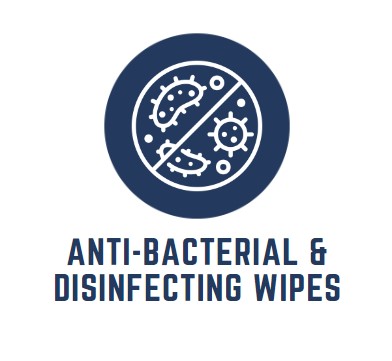The Rise of Antimicrobial Wet Wipes
The rise in the use and need for antimicrobial wet wipes indicates a notable change in public health and hygiene habits. Created for simple cleaning and freshening tasks, wet wipes have transformed into crucial instruments in combating infectious pathogens, due to the incorporation of sophisticated antimicrobial characteristics.
Antimicrobial wet wipes contain chemicals that can kill or prevent the growth of microorganisms such as bacteria, viruses, and fungi. This change is influenced by increasing attention to cleanliness as a result of worldwide health emergencies like the COVID-19 pandemic, and a greater comprehension of how illnesses propagate in shared and public areas.
These advanced items are utilized not merely in healthcare environments but have also become widespread in homes, schools, offices, and public transportation systems, offering a convenient and efficient method to guarantee surfaces and hands are sterilized. This has resulted in creative product advancements focused on enhancing the antibacterial efficacy of wipes while maintaining safety and environmental sustainability.
Wet wipes manufacturers are currently emphasizing the incorporation of several antimicrobial compounds such as benzalkonium chloride, triclosan, tea tree oil, and grapefruit seed extract, which provide numerous ways to prevent bacteria growth. The ingredients are chosen for their capacity to provide comprehensive protection while also satisfying consumer preferences for goods that are devoid of harsh chemicals.
The increase in antimicrobial wet wipes is backed by progress in non-woven textile technology, which improves the distribution and effectiveness of the active components. The substrates are engineered to be robust and soft, promoting effective cleaning and user comfort.
With the market growth, regulatory supervision has intensified to guarantee the efficacy of goods against infections and their safety for users, especially children and individuals with sensitive skin. This regulatory framework ensures stringent product quality and safety requirements, enhancing consumer confidence and promoting increased acceptance.
The increasing use of antimicrobial wet wipes demonstrates a proactive stance on cleanliness, highlighting the importance of prevention and safety in today’s health-conscious society.
Innovative Ingredients and Their Mechanisms
The progress in creating antimicrobial wet wipes is mainly due to using distinct chemicals, each with distinctive processes to efficiently fight against bacteria.
- Silver ions (Ag+): Silver ions are highly effective in antibacterial technologies. They function by engaging with bacterial cells through several mechanisms. Silver ions mostly adhere to bacterial cell walls and infiltrate them, resulting in structural harm that ultimately causes cell demise. Within the cell, they interfere with essential processes including DNA replication and enzyme function, hindering the cell’s capacity to proliferate. Silver ions are efficient against a wide range of bacteria, viruses, and some fungi due to their broad-spectrum activity.
- Zinc Oxide (ZnO): Zinc Oxide is valued for its skin-protective characteristics and its efficacy against viruses such as norovirus and rotavirus. Zinc oxide works by attaching to the surface proteins of viruses, preventing them from replicating and infecting host cells. The antiviral function is especially advantageous in personal care products where virus spread is a worry.
- Copper-Based Compounds: Copper-based compounds utilize the oligodynamic effect to effectively kill a broad spectrum of microorganisms. Copper damages bacterial cell membranes, causing critical cellular nutrients and ions to seep out, ultimately resulting in cell death. It disrupts the DNA and RNA replication pathway, halting the microbe’s reproduction. Copper’s effectiveness against viruses is due to its ability to alter viral proteins, making them non-infectious.
- Essential Oils: Essential oils like tea tree oil and thyme oil are being added more often because of their natural antibacterial capabilities. The oils consist of terpenes and phenolics, which can damage the cell walls of microorganisms and prevent their growth. Consumers are drawn to items with less synthetic ingredients due to their natural nature.
- Quaternary Ammonium Compounds (Quats): Quaternary ammonium compounds like benzalkonium chloride are surfactants known for their strong antibacterial capabilities. They function by disturbing the cell membranes of microorganisms, resulting in cell lysis and mortality. Quats are efficient against different infections and are frequently utilized in household and healthcare environments.
The substances are meticulously chosen and studied for both their antibacterial efficacy and their safety and compatibility with other components of wet wipes. Complex formulations can incorporate many agents to leverage their synergistic effects, boosting the antibacterial effectiveness of the wipes. Ongoing research in the sector involves refining mechanisms and investigating new possible ingredients to provide safer, more effective, and sustainable antibacterial products.
Biodegradable and Eco-Friendly Options
The wet wipes sector is developing novel solutions that promote eco-friendliness without sacrificing effectiveness in response to the growing importance of environmental awareness and sustainability. Biodegradable and eco-friendly wet wipes aim to minimize the environmental effects of these often-used items by tackling issues including waste buildup and long-term viability.
Biodegradable Materials
Transitioning to biodegradable materials in wet wipe production is a crucial tactic for decreasing environmental impact. Conventional wet wipes are typically composed of non-biodegradable synthetic fibers, resulting in substantial trash accumulation in landfills and potential blockages in sewage systems. Wet wipes manufacturers are using natural fibers that decompose more easily in the environment to address this issue.
- Bamboo fibers are commonly used in eco-friendly wet wipes because of their inherent antibacterial qualities and smooth texture. Bamboo is a sustainable resource because to its rapid growth, low water requirements, and lack of need for pesticides.
- Cotton is biodegradable and offers superior softness and strength in wet wipes. Organic cotton is cultivated without synthetic chemicals, making it safer for both the environment and the consumer.
- Wood pulp and cellulose, derived from plants, are sustainable and easily biodegradable in natural settings. Wood pulp and cellulose can be obtained from sustainably managed forests, which improves their environmental credentials.
Sustainable Manufacturing Processes
In addition to material modifications, the production methods for wet wipes are also changing to lessen their environmental impact.
- Water-Based Formulations: Numerous wet wipes manufacturers are transitioning to water-based solutions to minimize the utilization of strong chemicals. These formulations are more environmentally friendly and easier to process in wastewater systems.
- Energy Efficiency: Energy efficiency is prioritized in contemporary manufacturing plants to reduce energy usage. This involves utilizing renewable energy sources like solar or wind power and incorporating energy-efficient machinery and lighting systems.
- Minimizing Packaging: Decreasing the quantity of packaging for wet wipes, or transitioning to recyclable or biodegradable materials, substantially reduces waste. Advanced packaging options encompass refillable containers and simple designs.
Regulatory and Consumer Demands
Wet wipes manufacturers are being motivated to produce biodegradable and eco-friendly wet wipes due to legislation and market demand. Authorities are putting more stringent regulations on the biodegradability and environmental effects of personal care items. Consumers are increasingly seeking sustainable solutions and favoring products that reflect their environmental beliefs.
Enhanced Manufacturing Processes
The wet wipes sector has made substantial progress in enhancing production methods to elevate product quality, efficiency, and environmental sustainability. The improvements cater to the increasing consumer preference for high-performance and environmentally friendly products while also focusing on reducing production costs and environmental footprint.
Advanced Materials Processing
- Nonwoven Fabric Technology: Contemporary wet wipes are commonly crafted using nonwoven textiles, offering enhanced texture and durability in comparison to conventional woven materials. Progress in nonwoven technology involves air-laid, spunlace, and hydroentanglement methods that bind fibers together without using adhesives, leading to softer and more absorbent wipes.
- Biodegradable Fibers: The transition to biodegradable materials such as bamboo, cotton, and cellulose fibers has been crucial. Advanced processing methods guarantee the conversion of these materials into nonwoven fabrics while preserving their biodegradable characteristics.
Incorporation of Antimicrobial Agents
Antimicrobial compounds are crucially included in the fabric of wet wipes during manufacture.
- Impregnation Techniques: This entails saturating the nonwoven fabric with antimicrobial solutions while it is being manufactured. Saturation and spraying techniques help evenly spread antimicrobial chemicals in the material, making the wipes more effective against germs.
- Controlled Release Technology: Advanced methods include trapping antimicrobial compounds in microcapsules that are attached to the fibers of the wipes. The microcapsules gradually release the agent over time, extending the antibacterial effectiveness of the wipes after use.
Automated Robotics
Automation is essential for improving the efficiency and uniformity of wet wipes production.
- Robotic Assembly Lines: Robotic assembly lines are automated manufacturing systems that utilize robotic arms to handle materials and packing, leading to reduced labor costs and more production efficiency. Automation reduces human mistakes and guarantees uniform quality in all batches.
- Real-Time Quality Control: Sophisticated imaging and scanning technologies are employed to oversee the quality of wet wipes throughout the manufacturing process. The prompt identification and correction of flaws through real-time quality control guarantee that only items meeting rigorous quality criteria are sent to consumers.
Sustainable Manufacturing Practices
Sustainable manufacturing strategies are becoming more common in the business.
- Energy Efficiency: Contemporary buildings are constructed to reduce energy usage by energy-efficient equipment, streamlined processes, and occasionally by incorporating renewable energy sources.
- Waste Reduction: Wet wipes manufacturers are concentrating on waste reduction by recycling water and resources in the production process. Surplus nonwoven fabric can be reused or recycled to reduce industrial waste.
- Solvent-Free Formulations: Water-based adhesives and solvents are being replaced with environmentally friendly alternatives with lower volatile organic compound (VOC) emissions.
Prospective Paths
Future advancements in wet wipes manufacturing processes may involve incorporating artificial intelligence (AI) to boost production efficiency and anticipate maintenance requirements. Furthermore, further research on novel materials and chemical compositions may result in wet wipes that are even more efficient and environmentally friendly.
The wet wipes business can now fulfill growing market demands and address the crucial requirements for sustainability and environmental responsibility through improved manufacturing techniques.
Compliance and Safety Standards
Adherence to compliance and safety standards is crucial in the wet wipes sector to guarantee the safety, effectiveness, and environmental friendliness of goods as the industry evolves and grows. These standards are crucial for upholding customer trust and complying with the strict regulations established by regulatory authorities in various locations.
Regulatory Frameworks
- International and local regulations: Wet wipes regulation differs by location and typically covers safety, effectiveness, and labeling requirements. In the United States, wet wipes are controlled by the Environmental Protection Agency (EPA) if they are disinfecting wipes and by the Food and Drug Administration (FDA) if they are intended for personal care. The safety and environmental impact of wipes containing biocidal compounds in Europe is regulated by the Biocidal Products Regulation (BPR) and the General Product Safety Directive (GPSD).
- ISO Standards: The International Organization for Standardization (ISO) offers guidelines that affect different areas of wet wipe manufacturing, such as quality management (ISO 9001), environmental management (ISO 14001), and the testing of nonwoven fabrics in wipes (ISO 9073).
Safety Assessment
- Dermatological Testing: Dermatological testing is performed to verify the safety of wet wipes intended for human use, especially those used for personal care. This involves conducting patch tests to assess skin irritancy and allergy reactions, confirming that the wipes are hypoallergenic and suitable for sensitive skin.
- Microbiological Testing: Wet wipes should be devoid of pathogenic germs and fungi. Thorough microbiological testing is conducted to verify that the items adhere to the permissible bioburden requirements (the number of bacteria present on a non-sterilized product).
- Chemical Safety Assessments: The safety of the chemical components of wet wipes, such as preservatives, scents, and active substances, needs to be evaluated. This includes assessing the likelihood of chemical burns, toxicity, and enduring health consequences.
Adhering to Environmental Regulations
- Biodegradability and Compostability: Biodegradability and compostability are becoming more important due to rising environmental concerns, guaranteeing that wet wipes can break down naturally or be turned into compost. Tests are carried out to assess the speed and degree of biodegradation, following particular criteria such as ASTM D6400 for compostability or OECD guidelines for biodegradability.
- Regulations for Packaging: Packaging materials for wet wipes must adhere to regulatory standards, which may involve criteria for recyclability and minimizing plastic usage. Labeling requirements are essential for giving consumers instructions on how to correctly dispose of the product.
Regulatory Audits and Accreditation
Wet wipes manufacturers frequently undergo routine audits and must acquire certificates to confirm their compliance with safety and quality standards. Independent third-party organizations or internal teams might conduct these audits based on regulatory needs and company rules.
Upcoming Challenges
The wet wipes sector is encountering persistent issues in meeting compliance and safety standards due to rising consumer awareness and regulatory oversight. Advancements in materials and chemicals could create new regulatory challenges while achieving worldwide regulatory uniformity continues to be a complicated matter. Wet wipes manufacturers need to address these difficulties by consistently enhancing product testing, compliance management, and consumer education.
Compliance and safety regulations in the wet wipes sector aim to safeguard customers and the environment while promoting public health goals. As the sector progresses, these requirements are expected to become stricter, aligning with wider societal movements towards sustainability and consumer safety.
The Future of Antimicrobial Wet Wipes
Antimicrobial wet wipes are expected to see breakthroughs due to continuous research, changing customer preferences, and stricter regulations. The convergence of these variables is creating a dynamic pathway for the development of antimicrobial wet wipes that are more effective, sustainable, and user-friendly.
Improved Antimicrobial Effectiveness
- Advanced Antimicrobial Agents: Future advancements in antimicrobial agents are expected to concentrate on incorporating next-generation compounds that provide a wider range of effectiveness and lower possibility for resistance. Researchers are investigating new bio-based substances, such as peptides and enzymes, that may break down harmful germs with greater effectiveness and safety.
- Nanotechnology: Nanotechnology is being used in antibacterial wet wipes, which is an interesting new development. Nanoparticles, such as nano-silver, can improve the antibacterial qualities of wipes. The particles have a high surface area to volume ratio, enhancing interaction with bacteria and leading to more efficient pathogen removal.
- Smart Technology Integration: Smart technologies can be incorporated into wet wipes packaging to include indicators that change color to signal contamination or reduce the effectiveness of the antimicrobial agent. This could assist consumers in determining the optimal timing for using the wipes to achieve maximum effectiveness.
Enhanced Environmental Sustainability
- Biodegradable and Compostable Materials: Research is focusing on creating entirely biodegradable and compostable wet wipes due to the increasing concern about environmental effects. Innovations may consist of novel plant-based fibers and biodegradable plastics that dissolve more efficiently, leaving no detrimental residues.
- Eco-friendly Chemicals: Environmentally friendly ingredients in antimicrobial wet wipes will be developed further to reduce their environmental footprint. Future formulations may incorporate more plant-based antibacterial agents and solvents that biodegrade more easily in natural settings.
- Water Conservation: Due to worldwide water scarcity, producers may create innovative methods to decrease water usage in wet wipes production or design products that need less water for manufacturing.
Regulatory and Safety Improvements
- Tighter Regulations: The expanding wet wipes market is expected to prompt regulatory authorities worldwide to enforce more stringent safety and environmental regulations. These could involve implementing more stringent testing procedures for antimicrobial effectiveness and skin safety, along with more stringent regulations on labeling to guarantee transparency regarding components and disposability.
- Consumer Education: Wet wipes manufacturers must spend on consumer education programs to educate users on the right handling of antimicrobial wipes and appropriate disposal techniques to avoid environmental harm.
Customization and Variation
- Targeted Uses: Potential future product lines may include wipes customized for specific uses or situations, such as those intended for use in schools, hospitals, or public transportation. These specialty products may contain varying levels of antimicrobial agents tailored for certain infections commonly found in those regions.
- Consumer-Centric Innovations: Anticipate an increase in consumer-oriented innovations, including enhanced packaging for quicker dispensing and resealing of wipes, as well as formulations tailored for sensitive skin, demonstrating a wider consideration of consumer preferences and requirements.
Ultimately, advancements in technology will improve the antibacterial properties of wet wipes, but stricter regulations and a focus on sustainability and consumer education will shape their future. The advancements will enhance the efficiency and safety of these products while also bringing them in line with worldwide environmental objectives and public health priorities.







